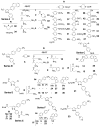Identification and characterization of a novel integrin-linked kinase inhibitor
- PMID: 21823616
- PMCID: PMC3182772
- DOI: 10.1021/jm2007744
Identification and characterization of a novel integrin-linked kinase inhibitor
Abstract
Integrin-linked kinase (ILK) represents a relevant target for cancer therapy in light of its role in promoting oncogenesis and tumor progression. Through the screening of an in-house focused compound library, we identified N-methyl-3-(1-(4-(piperazin-1-yl)phenyl)-5-(4'-(trifluoromethyl)-[1,1'-biphenyl]-4-yl)-1H-pyrazol-3-yl)propanamide (22) as a novel ILK inhibitor (IC(50), 0.6 μM), which exhibited high in vitro potency against a panel of prostate and breast cancer cell lines (IC(50), 1-2.5 μM), while normal epithelial cells were unaffected. Compound 22 facilitated the dephosphorylation of Akt at Ser-473 and other ILK targets, including glycogen synthase kinase-3β and myosin light chain. Moreover, 22 suppressed the expression of the transcription/translation factor YB-1 and its targets HER2 and EGFR in PC-3 cells, which could be rescued by the stable expression of constitutively active ILK. Evidence indicates that 22 induced autophagy and apoptosis, both of which were integral to its antiproliferative activity. Together, this broad spectrum of mechanisms underlies the therapeutic potential of 22 in cancer treatment, which is manifested by its in vivo efficacy as a single oral agent in suppressing PC-3 xenograft tumor growth.
Figures









Similar articles
-
The phosphoinositide-dependent kinase-1 inhibitor 2-amino-N-[4-[5-(2-phenanthrenyl)-3-(trifluoromethyl)-1H-pyrazol-1-yl]phenyl]-acetamide (OSU-03012) prevents Y-box binding protein-1 from inducing epidermal growth factor receptor.Mol Pharmacol. 2007 Sep;72(3):641-52. doi: 10.1124/mol.107.036111. Epub 2007 Jun 26. Mol Pharmacol. 2007. PMID: 17595327
-
Overcoming trastuzumab resistance in HER2-overexpressing breast cancer cells by using a novel celecoxib-derived phosphoinositide-dependent kinase-1 inhibitor.Mol Pharmacol. 2006 Nov;70(5):1534-41. doi: 10.1124/mol.106.023911. Epub 2006 Aug 3. Mol Pharmacol. 2006. PMID: 16887935
-
Inhibition of neurogenic and thromboxane A2 -induced human prostate smooth muscle contraction by the integrin α2β1 inhibitor BTT-3033 and the integrin-linked kinase inhibitor Cpd22.Prostate. 2020 Aug;80(11):831-849. doi: 10.1002/pros.23998. Epub 2020 May 25. Prostate. 2020. PMID: 32449814
-
Optimization of imidazo[4,5-b]pyridine-based kinase inhibitors: identification of a dual FLT3/Aurora kinase inhibitor as an orally bioavailable preclinical development candidate for the treatment of acute myeloid leukemia.J Med Chem. 2012 Oct 25;55(20):8721-34. doi: 10.1021/jm300952s. Epub 2012 Oct 8. J Med Chem. 2012. PMID: 23043539 Free PMC article.
-
Integrin-linked kinase, a promising cancer therapeutic target: biochemical and biological properties.Pharmacol Ther. 2002 Feb-Mar;93(2-3):233-42. doi: 10.1016/s0163-7258(02)00192-4. Pharmacol Ther. 2002. PMID: 12191615 Review.
Cited by
-
A novel HIF-1α-integrin-linked kinase regulatory loop that facilitates hypoxia-induced HIF-1α expression and epithelial-mesenchymal transition in cancer cells.Oncotarget. 2015 Apr 10;6(10):8271-85. doi: 10.18632/oncotarget.3186. Oncotarget. 2015. PMID: 25821081 Free PMC article.
-
Targeting extracellular matrix stiffness and mechanotransducers to improve cancer therapy.J Hematol Oncol. 2022 Mar 24;15(1):34. doi: 10.1186/s13045-022-01252-0. J Hematol Oncol. 2022. PMID: 35331296 Free PMC article. Review.
-
Significance of integrin-linked kinase (ILK) in tumorigenesis and its potential implication as a biomarker and therapeutic target for human cancer.Am J Cancer Res. 2019 Jan 1;9(1):186-197. eCollection 2019. Am J Cancer Res. 2019. PMID: 30755822 Free PMC article. Review.
-
Cardiac differentiation of human pluripotent stem cells using defined extracellular matrix proteins reveals essential role of fibronectin.Elife. 2022 Jun 27;11:e69028. doi: 10.7554/eLife.69028. Elife. 2022. PMID: 35758861 Free PMC article.
-
Function of Integrin-Linked Kinase in Modulating the Stemness of IL-6-Abundant Breast Cancer Cells by Regulating γ-Secretase-Mediated Notch1 Activation in Caveolae.Neoplasia. 2015 Jun;17(6):497-508. doi: 10.1016/j.neo.2015.06.001. Neoplasia. 2015. PMID: 26152358 Free PMC article.
References
-
- Mora A, Komander D, van Aalten DM, Alessi DR. PDK1, the master regulator of AGC kinase signal transduction. Semin Cell Dev Biol. 2004;15:161–170. - PubMed
-
- Dong LQ, Liu F. PDK2: the missing piece in the receptor tyrosine kinase signaling pathway puzzle. Am J Physiol Endocrinol Metab. 2005;289:E187–196. - PubMed
-
- Hresko RC, Mueckler M. mTOR. RICTOR is the Ser473 kinase for Akt/protein kinase B in 3T3-L1 adipocytes. J Biol Chem. 2005;280:40406–40416. - PubMed
-
- Sarbassov DD, Guertin DA, Ali SM, Sabatini DM. Phosphorylation and regulation of Akt/PKB by the rictor-mTOR complex. Science. 2005;307:1098–1101. - PubMed
Publication types
MeSH terms
Substances
Grants and funding
LinkOut - more resources
Full Text Sources
Other Literature Sources
Chemical Information
Molecular Biology Databases
Research Materials
Miscellaneous

